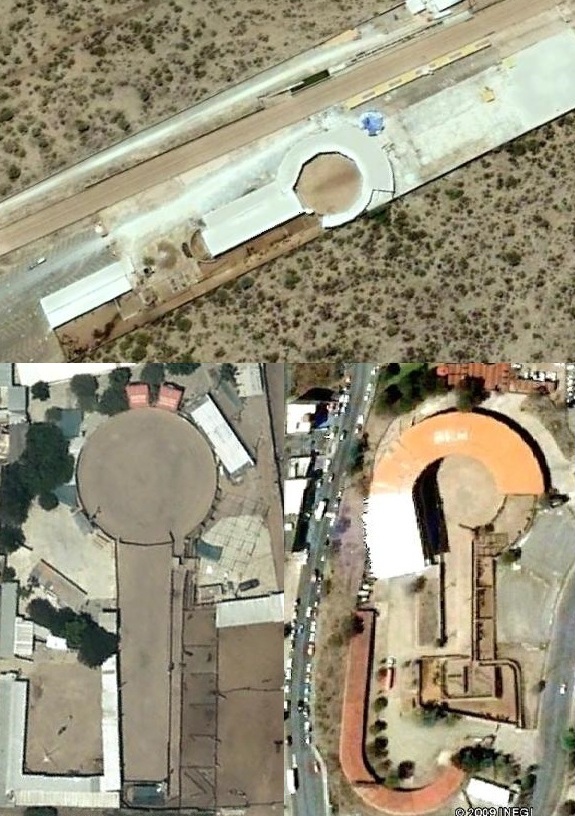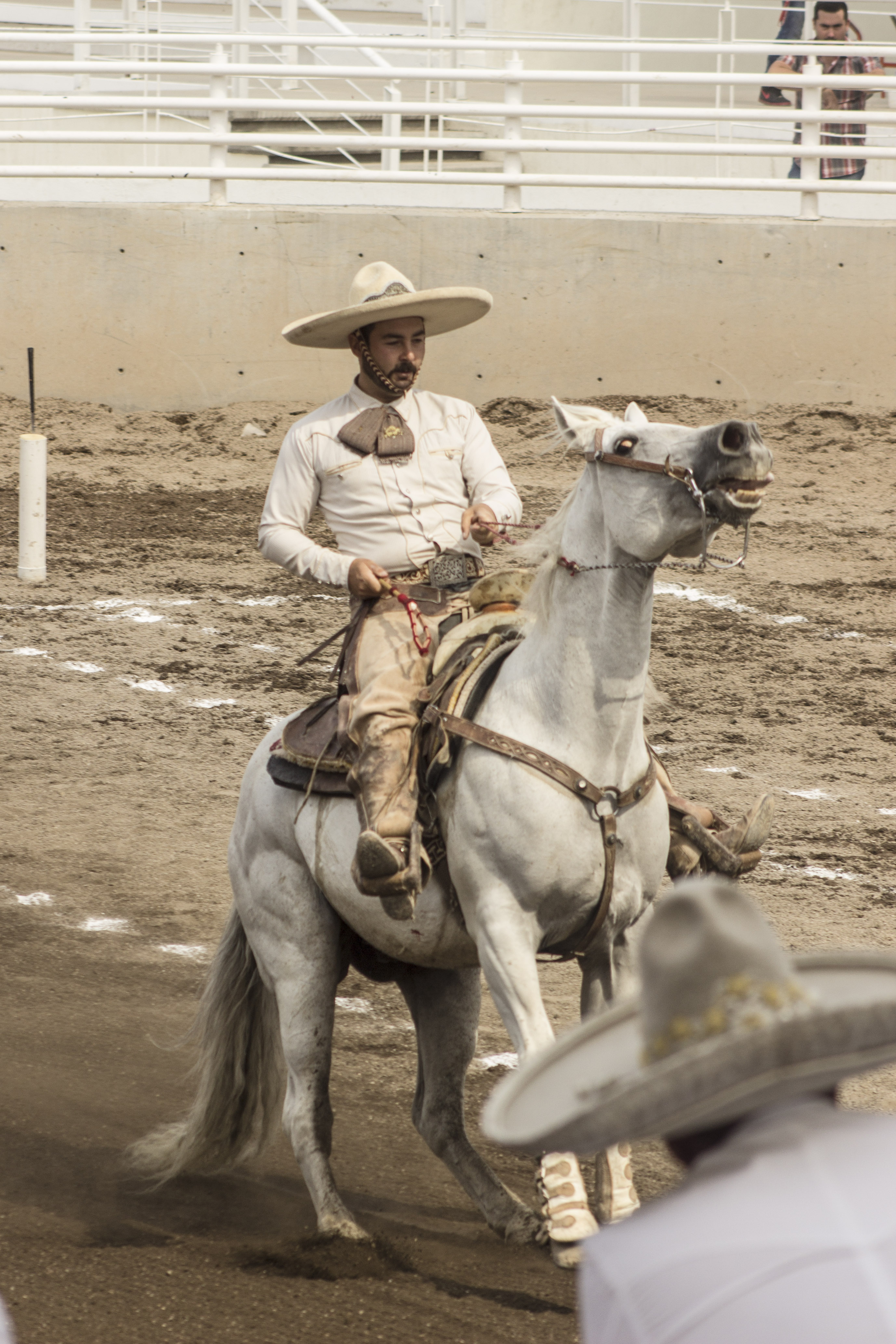|
Lienzo Charro
A ''lienzo charro'' is an arena where charros hold the events of '' charreada'', ''coleadero'' and jaripeo Jaripeo () refers to a form of bull riding practiced mainly in central and southern Mexico. It developed in the 16th century and originally involved riding fighting bulls to the death, but later evolved to where contestants attempt to ride buck ....Teresa Palomo Acosta American rodeo events may also take place at a lienzo charro. A ''lienzo'' has two areas: one and a second, circular area in diameter. ''Charreada'' is a team competition in which teams go head-to-head to win points in different competitions. The team with the most points at the end wins. The ''coleadero'', also known as the ''torneo de colas'', is a multi- or single-competitor event in which a mounted ''charro'' throws a bull to the ground by catching its tail, wrapping it under his leg, and making a turn.Andrea Cabello, Rocío Martínez and Montserrat Mata [2002Art of the Charrería: A Mexican Tradit ... [...More Info...] [...Related Items...] OR: [Wikipedia] [Google] [Baidu] |
Arena
An arena is a large enclosed platform, often circular or oval-shaped, designed to showcase theatre, musical performances, or sporting events. It is composed of a large open space surrounded on most or all sides by tiered seating for spectators, and may be covered by a roof. The key feature of an arena is that the event space is the lowest point, allowing maximum visibility. Arenas are usually designed to accommodate a multitude of spectators. Background The word derives from Latin ', a particularly fine-grained sand that covered the floor of ancient arenas such as the Colosseum in Rome, Italy, to absorb blood.. The term ''arena'' is sometimes used as a synonym for a very large venue such as Pasadena's Rose Bowl, but such a facility is typically called a ''stadium'', especially if it does not have a roof. The use of one term over the other has mostly to do with the type of event. Football (be it association, rugby, gridiron, Australian rules, or Gaelic) is typically played ... [...More Info...] [...Related Items...] OR: [Wikipedia] [Google] [Baidu] |
Charros
Charro has several meanings, but it generally refers to Mexican horse riders, who maintain traditional dress, such as some form of sombrero, which in Mexican Spanish are called ''sombrero de charro'' (a charro's hat). The charros could also be thought of as old Mexican cowboys who dress like such, although more modern dress is now seen on those who still work the ranches (''rancheros''). See also, '' vaquero''. Also old Mexican outlaws, bandits, revolutionaries, bounty hunters, and gunmen who wore similar dress are also called ''charro''. The traditional ''charro'' competition '' charreada'' (similar to a rodeo) has become the official sport of Mexico and maintains traditional rules and regulations in effect from colonial times up to the Mexican Revolution. Etymology The word ''charro'' (syn. ''charrar, charra'') is first documented in Spain in the book “Vocabulario de refranes y frases proverbiales” published in 1627 by Gonzalo Correas as a synonym of dumb or stupid ... [...More Info...] [...Related Items...] OR: [Wikipedia] [Google] [Baidu] |
Jaripeo
Jaripeo () refers to a form of bull riding practiced mainly in central and southern Mexico. It developed in the 16th century and originally involved riding fighting bulls to the death, but later evolved to where contestants attempt to ride bucking bulls until the animals tire and stopped bucking. Jaripeos traditionally take place in lienzo charros (another word by which it can be known is toriles) or bull rings, but can also take place in modern arenas. History The word Jaripeo derived from the Purépecha language in the Mexican state of Michoacán comes from Xarhipeo, the name of a village in said state. Dating back to 16th century Mexico, Jaripeo was originally a form of bull fighting in which the rider rode the bull to death. The Jaripeo later evolved to be seen as a test of courage rather than to just simply ride the bull to death. The modern objective of this event is to attempt to ride the bull until it becomes tame and stops bucking. At the present time, most of the occa ... [...More Info...] [...Related Items...] OR: [Wikipedia] [Google] [Baidu] |
Rodeo
Rodeo () is a competitive equestrian sport that arose out of the working practices of cattle herding in Spain and Mexico, expanding throughout the Americas and to other nations. It was originally based on the skills required of the working vaqueros and later, cowboys, in what today is the western United States, western Canada, and northern Mexico. Today, it is a sporting event that involves horses and other livestock, designed to test the skill and speed of the cowboys and cowgirls. American-style professional rodeos generally comprise the following events: tie-down roping, team roping, steer wrestling, saddle bronc riding, bareback bronc riding, bull riding and barrel racing. The events are divided into two basic categories: the rough stock events and the timed events. Depending on sanctioning organization and region, other events such as breakaway roping, goat tying, and pole bending may also be a part of some rodeos. The "world's first public cowboy contest" was held on Jul ... [...More Info...] [...Related Items...] OR: [Wikipedia] [Google] [Baidu] |
Footnotes
A note is a string of text placed at the bottom of a page in a book or document or at the end of a chapter, volume, or the whole text. The note can provide an author's comments on the main text or citations of a reference work in support of the text. Footnotes are notes at the foot of the page while endnotes are collected under a separate heading at the end of a chapter, volume, or entire work. Unlike footnotes, endnotes have the advantage of not affecting the layout of the main text, but may cause inconvenience to readers who have to move back and forth between the main text and the endnotes. In some editions of the Bible, notes are placed in a narrow column in the middle of each page between two columns of biblical text. Numbering and symbols In English, a footnote or endnote is normally flagged by a superscripted number immediately following that portion of the text the note references, each such footnote being numbered sequentially. Occasionally, a number between brack ... [...More Info...] [...Related Items...] OR: [Wikipedia] [Google] [Baidu] |
Mexican Culture
Mexican culture is primarily influenced by its Indigenous inhabitants and the culture of Spain. Mexican culture is described as the 'child' of both western and native American civilizations. Other minor influences include those from other regions of Europe, as well as Asia and Africa. First inhabited more than 10,000 years ago, the cultures that developed in Mexico became one of the cradles of civilization. During the 300-year rule by the Spanish, Mexico was a crossroads for the people and cultures of Europe and Latin America. The government of independent Mexico actively promoted shared cultural traits in order to create a national identity. The culture that is known is Mexico today, from Mariachis to Cowboys, were created by Mestizo people. The culture of an individual Mexican is influenced by familial ties, gender, religion, location, and social class, among other factors. Contemporary life in the cities of Mexico has become similar to that in the neighboring United States a ... [...More Info...] [...Related Items...] OR: [Wikipedia] [Google] [Baidu] |
Spanish Language
Spanish ( or , Castilian) is a Romance languages, Romance language of the Indo-European language family that evolved from colloquial Latin spoken on the Iberian peninsula. Today, it is a world language, global language with more than 500 million native speakers, mainly in the Americas and Spain. Spanish is the official language of List of countries where Spanish is an official language, 20 countries. It is the world's list of languages by number of native speakers, second-most spoken native language after Mandarin Chinese; the world's list of languages by total number of speakers, fourth-most spoken language overall after English language, English, Mandarin Chinese, and Hindustani language, Hindustani (Hindi-Urdu); and the world's most widely spoken Romance languages, Romance language. The largest population of native speakers is in Mexico. Spanish is part of the Iberian Romance languages, Ibero-Romance group of languages, which evolved from several dialects of Vulgar Latin in I ... [...More Info...] [...Related Items...] OR: [Wikipedia] [Google] [Baidu] |
Sport In Mexico
The most popular sport in Mexico currently is soccer, association football followed by boxing. However, there are regional variations: for example, baseball is the most popular sport in the northwest and the southeast of the country. Basketball, American football and bull riding (called "Jaripeo") are also popular. The tradition of bullfighting remains strong in Mexico. History of sport in Mexico Mesoamerican ball game The Pre-Columbian people of Mesoamerica have played the Mesoamerican ball game for over 3,000 years. Archaeologists found the oldest ballcourt yet discovered – dated to approximately 1400 BC – at Paso de la Amada in Mexico. The exact rules of the traditional ballgame remain unknown. Researchers believe that the sport probably resembled racquetball or volleyball, where the object is to keep the ball in play. The winner was sacrificed. In their Mesoamerican chronology, Post-Classical Era (1000–1697 CE), the Maya civilization, Maya began placing vertica ... [...More Info...] [...Related Items...] OR: [Wikipedia] [Google] [Baidu] |
Sports Originating In Mexico
Sport pertains to any form of competitive physical activity or game that aims to use, maintain, or improve physical ability and skills while providing enjoyment to participants and, in some cases, entertainment to spectators. Sports can, through casual or organized participation, improve participants' physical health. Hundreds of sports exist, from those between single contestants, through to those with hundreds of simultaneous participants, either in teams or competing as individuals. In certain sports such as racing, many contestants may compete, simultaneously or consecutively, with one winner; in others, the contest (a ''match'') is between two sides, each attempting to exceed the other. Some sports allow a "tie" or "draw", in which there is no single winner; others provide tie-breaking methods to ensure one winner and one loser. A number of contests may be arranged in a tournament producing a champion. Many sports leagues make an annual champion by arranging games in a ... [...More Info...] [...Related Items...] OR: [Wikipedia] [Google] [Baidu] |



_Salida_rabiosa.jpg)
.jpg)


.jpg)
